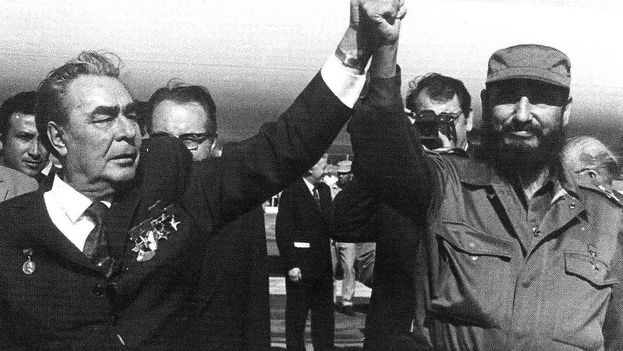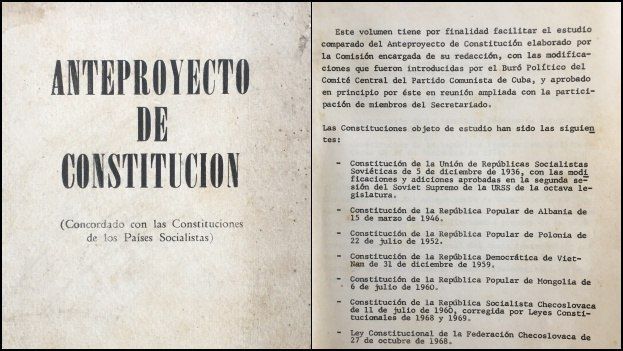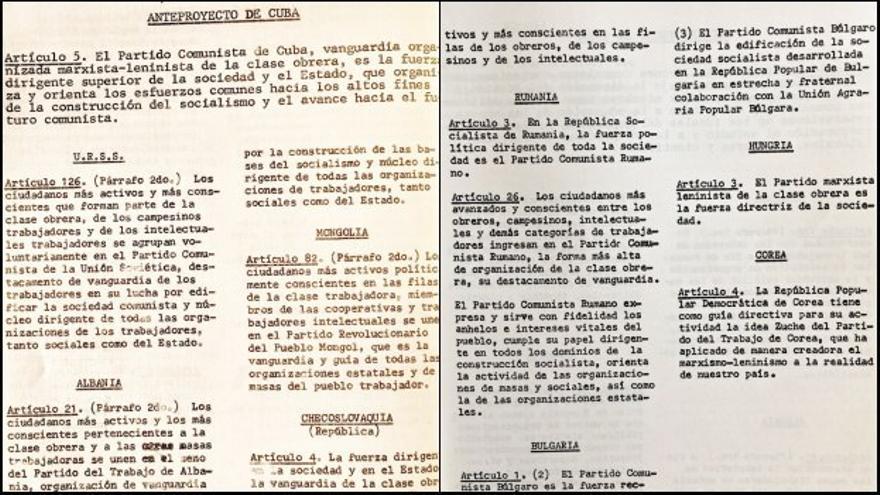
![]() 14ymedio, Reinaldo Escobar, Havana, 25 October 2018 — Hidden behind the guise of sovereignty and independence, the reality we see is often a model of elements or impositions that come from other latitudes. The reform of the Constitution that is currently being carried out in Cuba is not exempt from these contradictions, presenting as “ours” several points that have been copied from third parties.
14ymedio, Reinaldo Escobar, Havana, 25 October 2018 — Hidden behind the guise of sovereignty and independence, the reality we see is often a model of elements or impositions that come from other latitudes. The reform of the Constitution that is currently being carried out in Cuba is not exempt from these contradictions, presenting as “ours” several points that have been copied from third parties.
One of the most emblematic cases of this mimicry is Article 5 of the current project to reform the Cuban Constitution where the Communist Party of Cuba (PCC) is described as “the leading force of society and of the State.” Although this has been one of the points most rejected by the political opposition, few have dared to question it in public debates.
This definition of the superpower of the PCC in society was introduced in the first version of the draft of the Constitution of 1976, which a commission in charge of its drafting delivered to Fidel Castro on February 24, 1975. That text was approved by the Party’s Politburo in April of that same year, in a context of an ever increasing approach to the Soviet Union.

At that time, the text of the article underwent slight modifications from the preliminary draft to the final version. The most striking was the change of the definition of the PCC that went from reading the “organized Marxist-Leninist vanguard of the working class” to reading the “Martian [i.e. modeled on José Martí’s thought and writings] and Marxist-Leninist, organized vanguard of the Cuban nation,” to give it a more local touch that just barely managed to hide its deep foreign essence.
On February 15, 1976, a referendum was held in which more than five million voted, of which only 1% (54,070 people) dared to mark the ’No’ on the ballot. At that time Article 5 was seen by the vast majority of citizens entitled to vote as the formal definition of what everyone accepted as an accomplished fact, which was not worth trying to refute.
The failure of the 10 Million Ton sugar harvest, the collapse of the national economy and the visit of Leonid Brezhnev to the island in 1974 had cemented the Russian bear’s all-encompassing embrace around the Cuban model. That approach resulted in the sending of huge resources from the USSR to Cuba, but with the obligation on the part of the island’s nomenklatura to create structures and models of management and administration clearly compatible with the USSR.
The alignment with the Kremlin was reflected in the Constitution that was born, whose main body has survived to this day and is still present in several of the articles discussed in neighborhoods and workplaces.

That “copy and paste” was not a secret to anyone and a brochure internally circulated to Party cadres, published in limited edition in April 1975, clearly showed the elements that allow a comparative study between the articles proposed in the Cuban draft and other constitutions of various countries of what was then called “the socialist camp.”
The comparative study passed out among Party militants explained the affinities between the nascent Cuban Constitution and its close cousins in the Soviet Union, Albania, Poland, Vietnam, Mongolia, Czechoslovakia, Romania, the German Democratic Republic, Bulgaria, Hungary and North Korea. At that time Cuba did not consider China a socialist country and it did not enjoy the favor of the Plaza of the Revolution, so it was not included in the volume.
The concordance of article 5 of the Cuban Constitution with the definitions that appear in the laws of these countries reflects the conceptual similarity in expressing, in more or less the same words, that the entity in command in the country is none other than the party of the communists.
The Cuban model thus adopted a tight corset which contrasted with the first 16 years after 1959, when the country lacked an adequate Constitution to govern it. The Party began to organize its first congress and only nine months after Brezhnev’s visit to Havana, the commission in charge of writing the draft constitution was created, presided over by Blas Roca, a man who enjoyed the confidence of Moscow.
With the presence of Roca at the head of the task, the similarities between the Cuban Constitution and its Eastern European twins were assured. Creole traditions in constitutional issues were reduced to nothingness and the previously highly weighted sovereignty was diminished to the condition of symbol.
Today, the only country on the list with which Cuba maintains a constitutional agreement is North Korea. The rest have left in the past the pretensions of the compulsory leadership of the Communist Party. The articles that shielded the system did not do much to stop the democratizing thrust that those nations experienced. And when those nations’ constitutions wanted to stop reality they were, simply, repealed.
However, the proposal of Cuban constitutional reform, instead of looking for similarities with the democratic laws of Latin American countries based on the competitiveness of different political parties, continues to cling to the idea of imposing by law the prevalence of a single party. It is tied to precepts that have already demonstrated their failure.
Bad copies bring worse results and this case will not be the exception.
__________________________________
The 14ymedio team is committed to serious journalism that reflects the reality of deep Cuba. Thank you for joining us on this long road. We invite you to continue supporting us, but this time by becoming a member of 14ymedio. Together we can continue to transform journalism in Cuba.
